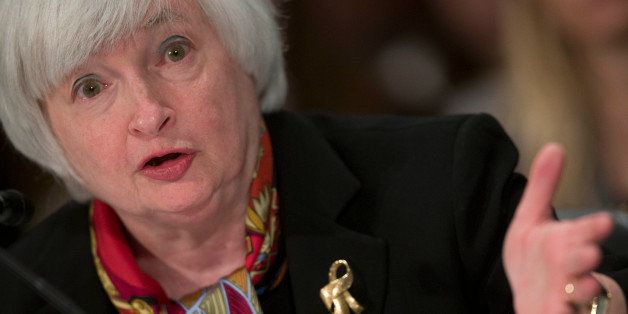
(Recasts first graph, adds comment from Yellen, market comment, adds bullets)
* Fed drops unemployment threshold for path of rates
* Monthly bond purchases cut by $10 bln as expected
* Most Fed policymakers see first rate hike in 2015
By Ann Saphir and Krista Hughes
WASHINGTON, March 19 (Reuters) - The Federal Reserve on Wednesday pushed forward with plans to slowly wind down its stimulus but said it will likely need to keep rates low even after the economy regains its health given lasting scars from the financial crisis.
In announcing its view on future rates after a two-day policy meeting, the Fed also dropped a set of guideposts it was using to help the public anticipate when it would finally start bumping overnight borrowing costs up from zero.
It said, however, that dropping a 6.5 percent unemployment rate as a guideline in deciding when to raise rates does not represent a change in its policy intentions. The Fed said it would instead consider a wide range of economic indicators when deciding the future path of overnight rates.
The central bank noted in its statement that its embrace of easy money policies could continue even after the Fed achieves its goals of full employment and 2 percent inflation.
In a news conference Fed Chair Janet Yellen said Fed officials cited "the residual impacts of the financial crisis" for this, with some noting "the potential growth rate of the economy may be lower at least for a time."
Even so, the majority of Fed policymakers expect overnight interest rates to rise in 2015. That, coupled with uncertainty about changes in the Fed's forward guidance, pushed U.S. stock prices lower and U.S. government yields higher.
The unease in markets "might be a sign that people think Yellen will tighten sooner rather than later, or that inflation could come into the market if the Fed keeps rates low well past 6.5 percent (unemployment)," said Wayne Kaufman, chief market analyst at Rockwell Securities in New York.
The central bank proceeded with its well-telegraphed reductions to its massive bond-buying stimulus, announcing it would cut its monthly purchases of U.S. Treasuries and mortgage-backed securities to $55 billion from $65 billion.
Minneapolis Fed President Narayana Kocherlakota dissented, saying that dropping the unemployment threshold could hurt the credibility of the Fed's commitment to return inflation to 2 percent.
MEASURED WIND DOWN
The decision to continue to scale back its stimulus keeps the Fed on track for the measured wind down laid out by Yellen's predecessor, Ben Bernanke. The Fed repeated that it plans to continue trimming the asset purchases in "measured steps" as long as labor conditions continue to improve and inflation shows signs of rising back toward the Fed's 2-percent goal.
The Fed's assessment of the U.S. economy chalked up recent weakness partly to adverse weather.
The Fed had said since December 2012 that it would not consider raising short-term rates until the jobless rate dropped to at least 6.5 percent, as long as inflation looked set to remain contained.
But the unemployment rate has fallen faster than anticipated, in part because of discouraged job hunters giving up the search, and officials think the economy is still far from ready for higher borrowing costs.
Of the Fed's 16 policymakers, only one believes it will be appropriate to raise rates this year; 13 expect a first rate hike next year, and two others see the first rate hike coming in 2016, according to fresh forecasts published on Wednesday. But once rate hikes start, Fed officials see slightly sharper increases than they did in December, with rates ending 2015 at 1 percent and ending 2016 at 2.25 percent, according to the median of forecasts.
In December, Fed officials expected short-term rates to be just 1.75 percent by the end of 2016.
The new forecasts also show Fed officials see unemployment dropping slightly faster, to between 5.6 percent and 5.9 percent by the end of 2015. In December their forecasts called for unemployment falling to between 5.8 percent and 6.1 percent by the fourth quarter of 2015.
KEEPING MARKETS IN LINE
The Fed has kept overnight rates near zero since December 2008 and has bought more than $3 trillion in long-term debt to keep borrowing costs down and spur investment and hiring.
It began to scale back its stimulus in December, announcing it would trim its monthly bond purchases by $10 billion, after it saw the economy pick up speed in the fall. In January, the Fed said it would cut the purchases by a further $10 billion.
At the same time, it has sought to tamp down any market expectations that rate rises will soon follow with its so-called forward guidance. But as the actual jobless rate neared the threshold, officials began to seek a more durable way to telegraph their view on when they will tighten monetary policy.
They want to keep market expectations aligned with their own forecasts. If traders start to price in earlier rate hikes, the result would be tighter financial conditions that could deter the very investment and hiring that the Fed wants to promote.
Many Fed officials, including Yellen, have said recent weakness in economic data, from jobs and retail sales to industrial production and home building, appears largely due to the unusually harsh winter and should soon dissipate. (Reporting by Ann Saphir and Krista Hughes; Editing by Tim Ahmann, Paul Simao and Andrea Ricci)
